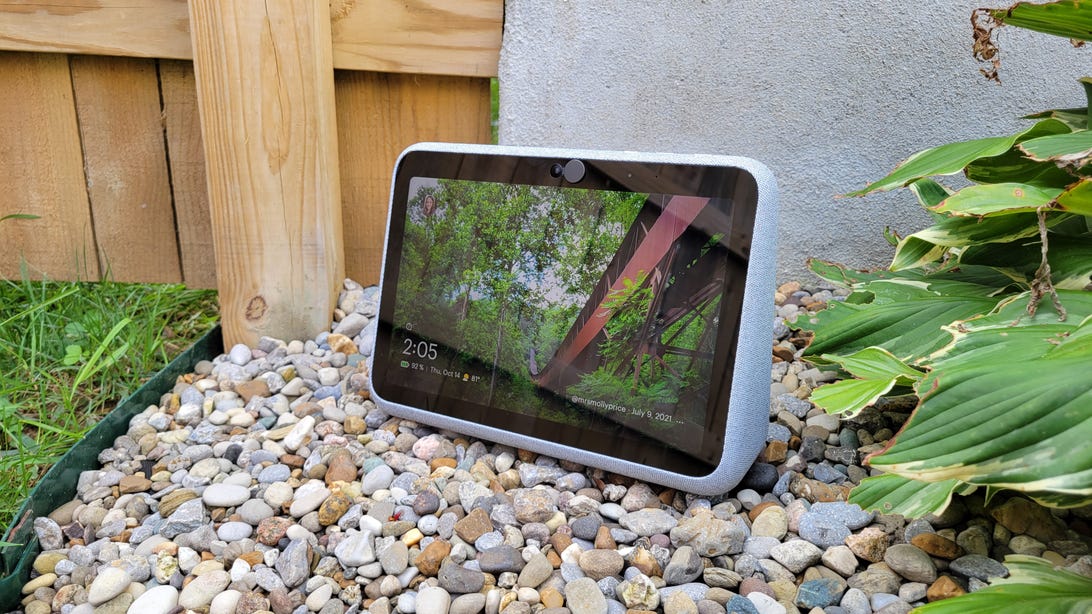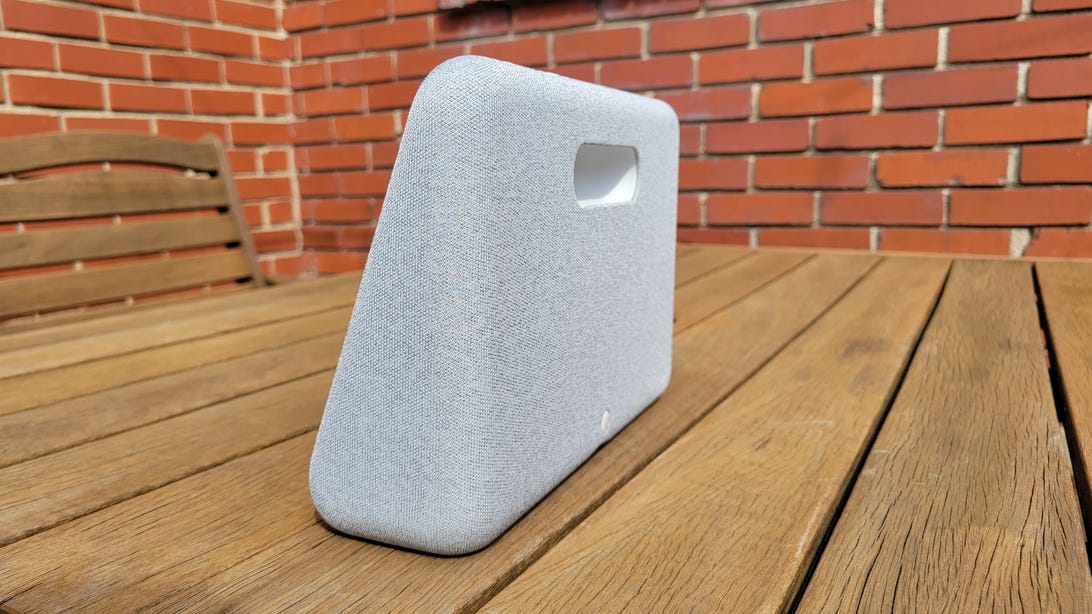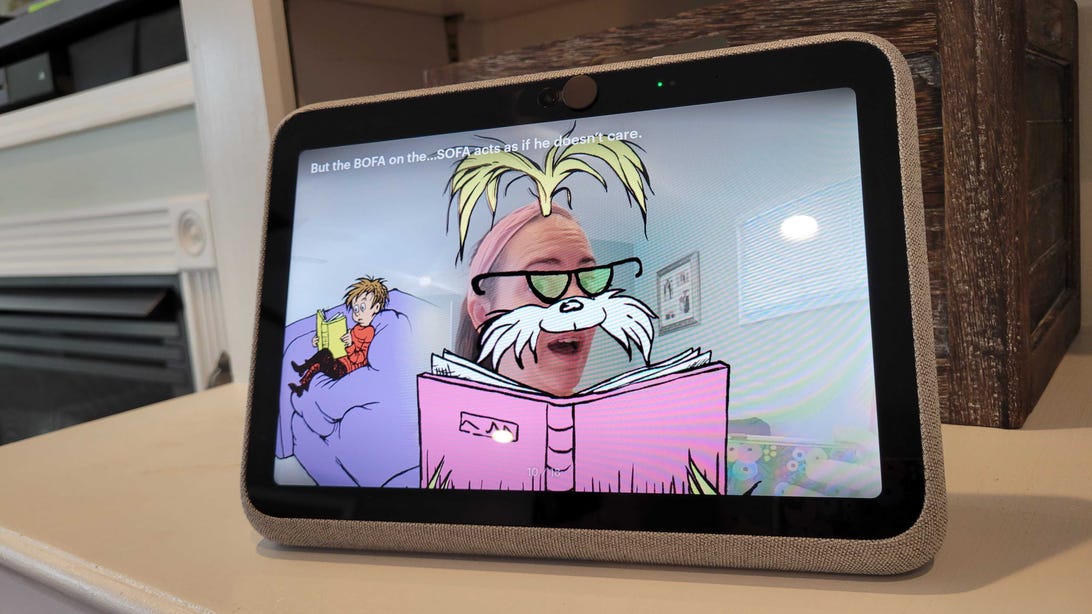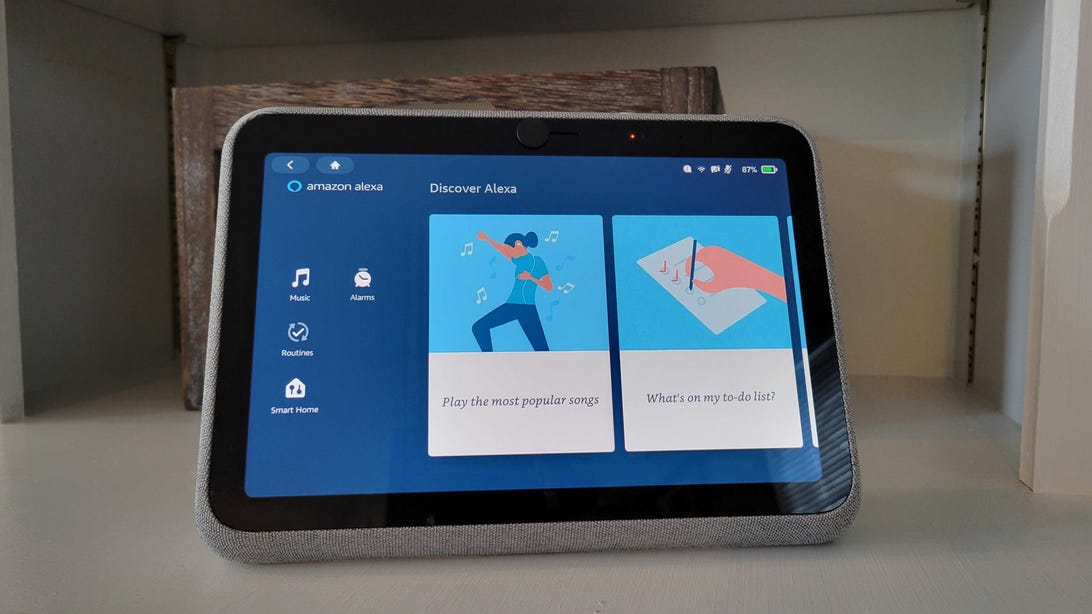
Facebook, despite its ongoing privacy troubles and Congressional inquiries, is pressing forward with hardware. The second generation of its Portal Plus smart display and the new, battery-powered Portal Go are now available. When I heard the pitch from Facebook representatives for a battery-powered smart display with a camera shutter and a handle, I was optimistic. At least, I thought, Facebook was doing something new -- a portable smart display.
Like
- Portability and comfortable size
- AR features and video chatting platforms
- Good camera and physical shutter
Don't Like
- Sometimes felt buggy and laggy
- Facebook's continued privacy concerns
- Doesn't outperform any tablet or smart display
After a week of testing, it's hard for me to recommend the Portal Go. Limited apps and unintuitive quirks combined with Facebook's overarching privacy issues are enough for me to steer everyone in another direction. If the $200 Portal Go had wowed me in any facet of my evaluation, I would give it its due praise. It just didn't. It's expensive and unnecessary. Still, there are interesting points and features. If you're going to skip out on the latest tech, you should know why. Let's dive into the details.
The obvious question
Like most folks, I wondered "Why not just buy a tablet?" After all, Portal has Alexa built-in but is far from focused on the smart home like the Nest Hub or an Echo Show. It's billed mostly as a chatting/meeting device. I asked Facebook directly and here's its spokesperson's response in full:
The first major difference is that Portal is focused on connecting people and it's built for the home, so we've made design choices that optimize for that. Portal also has a Smart Camera with an ultrawide field of view which is a differentiator for video calling – group calls feel more natural and calls tend to last longer. And with Facebook Assistant and Alexa Built-in, Portal enables hands-free functionality which is increasingly expected in places like the kitchen where your hands are often busy with other tasks.
We spoke a lot about Portal+ as a great work companion device, but Portal Go is also great as a second screen for work – you can free up your laptop so that you can connect with colleagues and be more productive by taking notes or reviewing other materials. And the audio on Portal is better – it's tuned for video calling and a great speaker when you are not on calls.
And, Portal is meant to be used as a communal device that is available for everyone in the home. Tablets are really designed as personal devices and aren't typically used in ways where household members can depend on them being available. Household mode is an example of how we are building on this – a computer for the house that can be shared, and anyone can use to make a call and deliver a more personalized experience through our support for multiple users.
There's a fair argument here for Portals being a better shared device than a tablet. Most parents I know don't want their kid handling their personal tablet, but that's also why so many kid-friendly models are out there. Big rubber cases and kid-friendly apps with parental control options deliver everything a family wants and needs in a portable interface.
The Portal Go includes settings to allow multiple users with customized experiences, so kids won't accidentally Zoom your boss. Not all smart displays include kid profiles in that manner, but many tablets do. Samsung's line of Galaxy Tabs has a Samsung Kids mode. iPads don't deliver as much here, but there is a "guided access" mode that locks out the touchscreen so you can plop on that one episode of Paw Patrol and go about your business.

The Amazon Fire HD 10 Kids Edition is made just for kids.
AmazonSpec-wise, both the Samsung Galaxy Tab A7 and the Amazon Fire HD 10 have a better screen resolution than the Portal (2,000x1,200 and 1,920x1,200 pixels respectively). The ability to download Amazon and Google smart home apps makes them decent tools for operating a smart home. Camera specs vary across tablets and displays, but the Portal Go isn't better than most of them when it comes to megapixels or field of view.
Design
Here's where Facebook gets a few points. I like the idea of a portable smart display. They're trying something new. It's not a tablet and it doesn't look like one. A built-in handle on the back of the Portal Go makes it easy to pick up. It's lightweight enough at three pounds. The thick base tapers up to the top for a sturdy, but still streamlined look.

The back of the Portal Go features a built-in handle.
Molly Price/CNETFabric covers the body of the display that houses two 5-watt, full-range speakers and one 20-watt woofer. The Portal Go puts out plenty of sounds for casual music and video streaming. I liked the intuitive, physical volume buttons on the top of the device.
It might not beat out a tablet option, especially if you buy a folio cover and prop your tablet up for viewing. It doesn't rotate like the Show 10, or even tilt like its larger sibling, the Portal Plus. Still, it's nice to look at and I enjoyed toting it around the house while I did chores and caught up on my favorite YouTube channels, via the Browser bookmark. It freed up my phone, tablet and my laptop.
Features
This is the limiting factor here for me. The Portal Go just doesn't do as much as any other tablet or smart display on the market. There are so few apps (24) that I have room to list them here. Imagine if I tried to do that with a tablet, Amazon Echo skills or Google Nest compatible apps and devices. We'd need a bigger internet. Here's the entire list, in alphabetical order:
- Alexa
- BlueJeans
- Browser
- Calendar
- CBS News
- Deezer
- Facebook Live
- Food Network
- GoToMeeting
- iHeartRadio
- Newsy
- Pandora
- Photo Booth
- Plex
- Red Bull TV
- SideChef
- Spotify
- Story Time
- Tidal Music
- Watch
- Webex Meetings
- Workplace
- Workplace Live
- Zoom
What's really odd here is what's missing. There's no native Facebook, Instagram, Messenger or WhatsApp app you can click on to open the platform. Features from those apps are built into various parts of the Portal experience. You can link your Instagram account to display your feed photos on the Portal Go's ambient screen. Messenger chat rooms can be created in the Portal Contacts app. You can use WhatsApp to set up the Portal instead of Facebook (but it will disable the "Hey, Portal" voice integration).
Facebook representatives told me that's because, "The core use for Portal is video calling and to make it easier for people to connect with their family, friends and colleagues. You can use the web browser on Portal to access your favorite Facebook apps. People have other devices they typically use for browsing Facebook, Instagram, etc."
That makes sense, I suppose. I'm not likely to scroll instagram on a display that isn't small and handheld or hunt and peck on a vertical touchscreen to reply to WhatsApp messages. Just be warned if you think this device is a one-stop shop for all your social apps -- it isn't.
Facebook could choose to add more apps with future updates. Other smart display makers have certainly done so in the past. It's possible that this list will expand. However, as it stands today, these are all your options for apps on the Portal Go.
Video chatting
You can video chat through Zoom, Webex, BlueJeans, GoToMeeting and Workplace. Facebook told me that Microsoft Teams support is in the works for later this year. Video calling your contacts happens through the Contacts app, where you'll create a Messenger room to chat. You can add up to seven people to your room, for a total of eight including yourself. The contacts available here are pulled from the WhatsApp or Facebook account you used to set up the Portal. The friends and family you call don't need to have a Portal device.
The Portal Go's AR camera and add-ins like Story Time are the big selling points here. Tapping the Experiences button in your video calls can add fun filters and special effects. There you'll find the safe effects and filters from the Photo Booth app, as well as access to Story Time, Photo Casting and the Watch Together feature for streaming Facebook Watch content.

A scene from the Dr. Seuss book There's a Wocket in my Pocket.
Molly Price/CNETOpen Story Time during a call and you'll find dozens of fun stories with filters and special effects that interact with the story teller on camera. Content includes Dr. Seuss, Pete the Cat, Llama Llama, Todd Parr and Jon Burgerman. There are also classic stories like Three Little Pigs, Itsy Bitsy Spider and Little Red Riding Hood. It really is fun and interactive and I wish it were available on better devices.
Alexa on Portal
Alexa is built into the Portal Go. You can access it via voice or from the Alexa app. In the app, a familiar Alexa dashboard displays your devices and has menu options for music, devices and more. Some Easter egg features like Alexa's recent Halloween routine with special effects and sounds didn't work on the Portal Go or Plus. The correct screen appeared, but the audio glitched and skipped most of the content. That's a small thing, but something you wouldn't encounter on an Amazon display.
Like previous models, the Portal Go has both "Hey, Portal" and Alexa capability. It certainly doesn't simplify anything and it sometimes leaves you wondering, "Wait, which assistant am I supposed to ask for this?"

The Alexa dashboard on the Portal Go shows options for using the assistant.
Molly Price/CNET"Hey, Portal" commands control things like calling, playing music, putting the device to sleep and even some general knowledge. That means there's overlap between "Hey, Portal" (you can also say "Hey, Facebook") and Alexa, who is primarily present to answer general questions, set reminder, control smart home devices and all the normal Alexa things you'd expect.
The last thing a smart device should do is prompt more thinking or decision making when you're trying to use it. The split personality here doesn't feel intuitive enough to be useful.
Privacy
Adjacent to any Facebook hardware is the ongoing saga of Facebook's data and privacy failings. You can dig deeper into the Portal privacy features here, but these are the big takeaways:
Portal devices are listening for the "Hey, Portal" wake word. If it hears that phrase, Portal sends a short transcript and recording of the voice interaction to Facebook. Stored "Hey, Portal" and "Hey, Facebook" voice interactions are kept on Facebook's servers for up to three years, while "false wakes" are deleted within 90 days of detection.
You can review and delete voice interactions recorded and transcribed from the "Hey, Portal" prompt. You can also choose to disable voice interaction recording all together, though it is on by default. If you only connect your Portal to WhatsApp and not Facebook, "Hey, Portal" won't work at all, due to WhatsApp's end-to-end encryption.
You can disable the camera and microphone by tapping the mute button on the top of the device or sliding the camera's physical cover. A red light indicates those features are disabled. The Portal Go's camera uses AI technology that is processed locally, not on Facebook servers. The Portal Go's camera does not use facial recognition.

A physical shutter, red light and on-screen notification let you know the camera and microphones are off.
Molly Price/CNETThere are two ways you could approach Portal alternatives. If you're looking for streaming, lots of apps, including social media but liked the portability of the Portal Go, get a tablet. Nearly any model from Samsung, Amazon or Apple will give you more capability, processing power and options for streaming and social media platforms. Throw in an Apple Pencil, S Pen or generic stylus and you've got even more flexibility.
If you're hoping for an Alexa-focused smart home device, the Echo Show 8 and Echo Show 10 are both fantastic (and often more affordable) options with broader apps for streaming and video chatting.
The following charts compare popular tablets and smart displays with the Portal Plus and Portal Go.
Portals vs. tablets
| Portal Go | Portal Plus | Galaxy Tab A7 | Amazon Fire HD 10 | iPad (2021) | |
|---|---|---|---|---|---|
| Price | $200 | $350 | $650 | $150 | from $329 |
| Screen size | 10.1 inches | 14 inches | 11 inches | 10.1 inches | 10.2 inches |
| Resolution | 1,200x800 | 2,160x1,440 | 2,560x1,600 | 1,920x1,200 | 2,160x1,620 |
| Camera | 12 megapixels | 12 megapixels | 8 megapixels front, 13 and 5 megapixels rear | 2 megapixels front, 5 megapixels rear | 12 megapixels front, 8 megapixels rear |
| Physical shutter | Yes | Yes | No | No | No |
| Field of view | 125 degrees | 131 degrees | 80 degrees | Not listed | 122 degrees |
| Portable | Yes | No | Yes | Yes | Yes |
| Kid mode | Yes | Yes | Yes | Yes | Limited (Guided Access) |
| Video apps | Zoom, Webex, BlueJeans, GoToMeeting, Workplace | Zoom, Webex, BlueJeans, GoToMeeting, Workplace | All available from the Google Play Store | All available from the Amazon app store | All available from the App Store |
| Music apps | Deezer, Pandora, Spotify, Tidal, iHeartRadio | Deezer, Pandora, Spotify, Tidal, iHeartRadio | All available from the Google Play Store | All available from the Amazon Appstore | All available from the App Store |
| Streaming apps | Facebook Watch, Red Bull TV, Food Network, Facebook Live, CBS News, Plex | Facebook Watch, Red Bull TV, Food Network, Facebook Live, CBS News, Plex | All available from the Google Play Store | All available from the Amazon Appstore | All available from the App Store |
| Smart home compatibility | Alexa | Alexa | Alexa app, Google Assistant app | Alexa | Siri, Alexa app, Google Assistant app |
| Internet browser | Yes | Yes | Yes | Yes | Yes |
Portals vs. smart displays
| Portal Go | Portal Plus | Nest Hub Max | Echo Show 8 | Echo Show 10 | |
|---|---|---|---|---|---|
| Price | $200 | $350 | $229 | $100 | $250 |
| Screen size | 10.1 inches | 14 inches | 10 inches | 8 inches | 10.1 inches |
| Resolution | 1,280x800 | 2,160x1,440 | 1,280x800 | 1,280x800 | 1,280x800 |
| Camera | 12 megapixels | 12 megapixels | 6.5 megapixels | 13 megapixels | 13 megapixels |
| Physical shutter | Yes | Yes | No | Yes | Yes |
| Field of view | 125 degrees | 131 degrees | 127 degrees | 110 degrees | 110 degrees |
| Portable | Yes | No | No | No | No |
| Kid mode | Yes | Yes | No | Yes | Yes |
| Video apps | Zoom, Webex, BlueJeans, GoToMeeting, Workplace | Zoom, Webex, BlueJeans, GoToMeeting, Workplace | Zoom, Google Duo | Zoom, Skype, Chime | Zoom, Skype, Chime |
| Music apps | Deezer, Pandora, Spotify, Tidal, iHeartRadio | Deezer, Pandora, Spotify, Tidal, iHeartRadio | Apple Music, Spotify, YouTube Music, Pandora, iHeartRadio, Deezer | Apple music, Spotify, Pandora, Amazon Music, Audible, SiriusXM, Headspace, NPR and more | Apple music, Spotify, Pandora, Amazon Music, Audible, SiriusXM, Headspace, NPR and more |
| Streaming apps | Facebook Watch, Red Bull TV, Food Network, Facebook Live, CBS News, Plex | Facebook Watch, Red Bull TV, Food Network, Facebook Live, CBS News, Plex | Netflix, Youtube, CW, HBONow, Starz, Red Bull TV, Crackle | Netflix, Hulu, Amazon Prime, Food Network, Red Bull TV, Tubi | Netflix, Hulu, Amazon Prime, Food Network, Red Bull TV, Tubi |
| Smart home compatibility | Alexa | Alexa | Alexa | Alexa | |
| Internet browser | Yes | Yes | No | Yes | Yes |
"smart" - Google News
October 20, 2021 at 08:00PM
https://ift.tt/3G4on93
Facebook Portal Go: A battery-powered smart display that doesn't make sense - CNET
"smart" - Google News
https://ift.tt/2P2kUhG
https://ift.tt/3febf3M
Bagikan Berita Ini















0 Response to "Facebook Portal Go: A battery-powered smart display that doesn't make sense - CNET"
Post a Comment